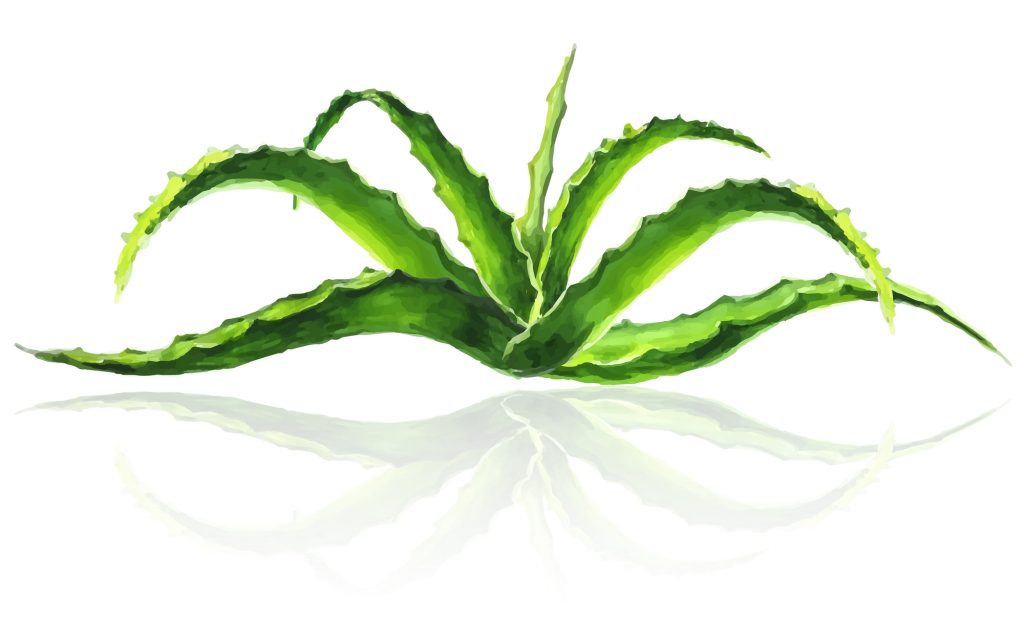Aloe vera plants are popular household additions, but all of a sudden, your beloved aloe vera plant is beginning to look a little droopy. Its leaves have started to bend, and you want to know why. And most importantly, you want to know how to fix it.
Aloe vera leaves can bend for a number of reasons, the most common of which is a lack of sufficient light. However, bending aloe vera leaves can also be caused by poor watering practices, fungal/bacterial diseases, low temperature, and improper containers, among other factors.
Thankfully, there are feasible solutions to each of these problems, and this article will be your guide to the whys, what’s, and hows of aloe vera maintenance! Wild aloe species are known to live up to 100 years, so don’t panic – your aloe vera plant will be just fine.
Why Are My Aloe Vera Leaves Bending?
In order to know how to fix your bent aloe vera and prevent the leaves from bending in the future, it is important to understand what causes aloe vera leaves to bend in the first place.
Insufficient Light
One of the most common reasons for aloe vera leaves bending is insufficient light. Aloe vera plants require a lot of sunlight, and although artificial light works fairly well, direct sunlight is ideal as it is best for photosynthesis.
Insufficient light can cause the aloe leaves to weaken and eventually bend (however, it is important to keep in mind that too much direct sunlight can also cause damage, resulting in reddened and bent leaves as the water evaporates).
Poor Watering Practices
Another common reason for aloe vera leaves bending is poor watering practices. Aloe plants do not need much water and only need to be watered once every two weeks (although the watering frequency varies based on the season, in hotter climates, aloe plants will require a bit more water).
It can be easy to overwater your plant, particularly in an attempt to save it, but underwatering an aloe plant is much better than overwatering, which can cause the leaves to wilt and bend and is much more difficult to recover from.
Fungal Diseases
Fungal diseases can cause the leaves of an aloe vera plant to bend. One of the most well-known and destructive fungal diseases that impact aloe plants is dry rot. Dry rot is a fungal disease that dries out the plant from the inside. This causes the leaves to weaken and bend, which is one of the first signs of dry rot disease.
Low Temperature
Like other desert plants, aloe vera plants thrive in warm and sunny environments. The ideal temperature for aloe plants is between 64 and 77 degrees Fahrenheit. When exposed to temperatures below 50 degrees Fahrenheit, the leaves of an aloe plant may begin to bend as it becomes susceptible to the cold.
This can be caused by various factors, but commonly it is from exposure to cold air from a window or water that is too cold being used to water the plant.

Poor Potting
When it comes to aloe vera plants, having the correct container is incredibly important for their growth and development. While they don’t need overtly huge pots, pots that are too small and/or too shallow can cause an array of problems.
Aloe vera plants require lots of space to grow and for their roots to expand, and containers/pots that are too shallow can cause the plant to become suffocated and cramped, resulting in drooping and bent leaves.
Bacterial Infections
Young aloe vera plants, in particular, are susceptible to bacterial infections because they don’t have the proper immune system that is required to fight them off. One of the first signs of a bacterial infection is often bent leaves, which occur as the plant weakens and can indicate infections such as soft rot disease, which is common among aloe vera plants.
Can You Fix Bending Leaves Of Aloe Vera?
Unfortunately, once the leaves are bent, there is no way to revitalize or unbend them, and therefore it is best to remove them and use them later so they don’t go to waste. However, just because some of the leaves are bent does not mean that the plant is not able to be saved or that you can’t prevent leaves from bending in the future.
Before attempting to revive your aloe plant, you should make sure it can actually be saved. If your plant has bent leaves but is showing signs of improvement, it is definitely salvageable and worth the time and effort! But if the leaves are wilting and turning a darker color, it might be time to part with your plant.
Should I Cut Bent Aloe Leaves?
You can, and should, cut off aloe vera leaves that have bent. It is actually optimal for the health and appearance of the plant.
Once bent, the leaves will not recover and unbend on their own, and this can inhibit the overall growth of the plant. It is also a good idea to remove yellowing or infected leaves because they are permanently damaged and will only hinder the plant’s health and wellbeing.
Removing bent and dying leaves can help to revive the aloe and encourage new growth. It will also allow the plant to return to its original shape, returning it to its former glory and beauty. An added plus is that the leaves can be used for healing properties, so they won’t go to waste if you remove them!
How To Keep Aloe Leaves From Bending
Due to the fact that bent aloe leaves cannot be revived, it is important to take preventative measures to keep your plant healthy and to keep the leaves from bending.
Sufficient Lighting
Sufficient lighting is crucial to keeping an aloe vera plant healthy and in good shape. These plants need around six to twelve hours of direct sunlight, but the occasional shade is also important. Leaving your aloe plant on a windowsill or another well-lit area will help to keep it healthy and allow photosynthesis to occur, keeping the leaves from wilting but also giving it some shelter from the sun.
Good Watering Practices
Aloe vera plants need a well-balanced and well-planned amount of water, and it is important to avoid overwatering and underwatering your plant. However, it is best to underwater an aloe plant, as this is easier to revive and recover from, whereas overwatering can cause permanent damage and drown your plant, which can cause the leaves to droop.
Watering frequency varies depending on the season, but once every two weeks is typically sufficient.
Proper Potting
Having a proper pot or container for your aloe vera plant is important to prevent the leaves from bending. If the container is too small or too shallow, the roots won’t have enough space, and the plant can become cramped and suffocated, causing the leaves to bend and lose their strength.
Larger pots with proper drainage allow the plants to have enough space to grow without suffocating or becoming overwatered.
Adequate Temperature
If aloe plants become too cold, it can cause the leaves to bend or wilt. To prevent this, it is important to make sure that your plant is kept in a warm area.
Aloe plants are typically well adapted to changes in temperature and can handle temperatures above 78 degrees Fahrenheit. However, they cannot withstand frost, and it is best to keep the temperature of their environment above fifty degrees Fahrenheit.
Good Soil
Aloe vera plants grow best in certain types of soil, which can help encourage healthy plants and therefore keep the leaves from bending.
Soil can be prepared from sand, leafy soil, turf, and humus, and you could also use a soil mixture specifically pre-prepared and packaged for aloe plants. Having loose, drainable soil is optimal for aloe plants, and if you need to further loosen the soil, you can add some charcoal or brick chips.
Annual Transplantation
Aloe vera plants require annual transplanting, and every time it is transplanted, it’s important to move your plant to a bigger pot to encourage continued growth. Once your aloe plant reaches a more mature size, you can repot it once every three or so years or replace the topsoil to keep it healthy, which will help to prevent the leaves from bending.
Preventing Diseases
Fungal and bacterial diseases can cause a significant amount of damage to aloe vera plants, including the bending and wilting of leaves. These diseases and infections can be easily prevented by taking proper care of the plant, following the above tips such as proper light and watering practices, all of which keep the plant healthy and can therefore prevent diseases.
How To Remove Bending Leaves From Aloe Vera Plant
If there are bent leaves on your aloe vera plant, there are a number of ways to remove them in order to keep the rest of the plant healthy, and they are all quick, safe, and easy solutions!
Cut off the Leaves with Shears
When removing aloe vera leaves from a damaged or suffering plant, it is important to use clean shears. Prior to using the shears, it is crucial that they are sterilized with alcohol in order to prevent the plant from getting any kind of infection.
For small to medium plants, a knife is adequate to use to cut off the leaves, while shears are best used for larger aloe plants. It is also important that the blade used is sharp enough to create a clean cut rather than to saw at the plant and potentially create more unnecessary damage.
Cut from the Base
To remove aloe vera leaves from the plant, rather than starting toward the middle of the plant or higher up, you should start by removing the leaves at the base of the plant. It is also important to be careful when cutting leaves off of the aloe plant to avoid harming the stem or other healthy leaves that are important to keep the plant thriving and growing.
Use Rubber Bands
It is easy to accidentally cut off healthy leaves when trying to remove bent ones on an aloe vera plant; however, there are a few ways to avoid this in order to keep the plant as healthy and viable as possible.
A common way to isolate the leaves you want to cut, in this case, the bent or damaged leaves is by using rubber bands to tie the healthy leaves together, facilitating the pruning process to clean up the plant more efficiently.
Bend the Leaf Downward
Similar to the use of rubber bands, bending the leaf you wish you remove down away from the rest of the leaves will help to isolate it. This allows you to safely cut off the desired leaf or leaves and refrain from accidentally removing the healthy ones and weakening the remainder of the plant.
Pull off the Leaves
Although it is often simpler and more efficient to just cut off the aloe leaves, it is also possible to remove bent or damaged leaves by pulling them off. This is most commonly done during the re-potting process, and you can carefully peel off the leaves from the base. Leaves that are already weakened or dead will come off particularly easily.
Conclusion
Aloe vera plants are excellent to grow and take care of; however, under certain conditions, their leaves can begin to bend and droop, indicating that something needs to be changed in order to keep them in good health.
There are several factors that could cause aloe vera leaves to bend, such as insufficient light, poor watering practices, shallow potting and containers with poor drainage, adequate temperature, and diseases or infections.
At the end of the day, each of these problems has feasible solutions, but in order to keep the plant healthy and growing well, it is crucial to remove the bent or dying leaves. Maintaining good care routines for your aloe plant will prevent its leaves from bending in the future.








